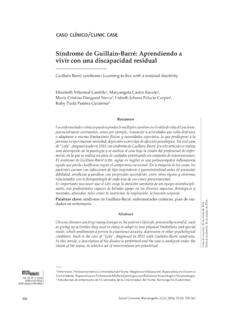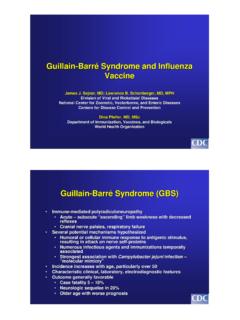Transcription of Guillain–Barre´ syndrome associated with normal …
1 ORIGINAL COMMUNICATIONG uillain Barre syndrome associated with normal or exaggeratedtendon reflexesNobuhiro Yuki Norito Kokubun Satoshi Kuwabara Yukari Sekiguchi Masafumi Ito Masaaki Odaka Koichi Hirata Francesca Notturno Antonino UnciniReceived: 29 August 2011 / Revised: 9 November 2011 / Accepted: 13 November 2011 / Published online: 6 December 2011 Springer-Verlag 2011 AbstractAreflexia is part one of the clinical criteriarequired to make a diagnosis of guillain Barre syndrome (GBS). The diagnostic criteria were stringently developedto exclude non-GBS cases but there have been reports ofpatients with GBS followingCampylobacter jejunienteritiswith normal and exaggerated deep tendon reflexes (DTRs).The aim of this study is to expand the existing diagnosticcriteria to preserved DTRs. From the cohort of patientsreferred for anti-ganglioside antibody testing from hospi-tals throughout Japan, 48 GBS patients presented withpreserved DTR at admission.
2 Thirty-two patients had nor-mal or exaggerated DTR throughout the course of illnesswhereas in 16 patients the DTR became absent or dimin-ished during the course of the illness. IgG antibodiesagainst GM1, GM1b, GD1a, or GalNAc-GD1a were fre-quently present in either group (84 vs. 94%), suggesting aclose relationship between the two groups. We theninvestigated the clinical and laboratory findings of 213 GBS patients from three hospital cohorts. In 23 patients,eight presented with normal tendon reflexes throughout theclinical course of the illness. Twelve showed hyperreflexia, with at least one of the jerks experienced even at nadir, andexaggerated reflexes returning to normal at recovery. Theother three had hyperreflexia throughout the disease to 190 GBS patients with reduced or absentDTR, the 23 DTR-preserved patients more frequentlypresented with pure motor limb weakness (87 vs.)
3 47%,p= ), could walk 5 m independently at the nadir(70 vs. 33%,p= ), more frequently had antibodiesagainst GM1, GM1b, GD1a, or GalNAc-GD1a (74 ,p= ) and were more commonly diagnosed withacute motor axonal neuropathy (65 vs. 34%,p= )than with acute inflammatory demyelinating polyneuropa-thy (13 vs. 43%,p= ). This study demonstrated thatDTRs could be normal or hyperexcitable during the entireclinical course in approximately 10% of GBS patients. Thispossibility should be added in the diagnostic criteria forGBS to avoid delays in diagnosis and effective treatment tothese Barre syndrome Acute motoraxonal neuropathy Acute inflammatory demyelinatingpolyneuropathy Anti-ganglioside antibody Campylobacter jejuni Tendon reflexIntroductionClinical diagnostic criteria for guillain Barre syndrome (GBS) requiring universal areflexia or hyporeflexia, as wellas progressive motor weakness of more than one limb,N.
4 Yuki (&)Departments of Microbiology and Medicine, National Universityof Singapore, Block MD4A, Level 5, 5 Science Drive 2,Singapore 117597, Singaporee-mail: Kokubun M. Ito M. Odaka K. HirataDepartment of Neurology, Dokkyo Medical University,Tochigi, JapanS. Kuwabara Y. SekiguchiDepartment of Neurology, Graduate School of Medicine,Chiba University, Chiba, JapanF. Notturno A. UnciniDepartment of Neurosciences and Imaging,University G. d Annunzio , Chieti, ItalyF. Notturno A. UnciniNeurocenter of Southern Switzerland (EOC),Lugano, Switzerland123J Neurol (2012) 259:1181 1190 DOI proposed in 1978 by an ad hoc committee of theNational Institute of Neurological and CommunicationDisorders and Stroke following the increased incidence ofGBS associated with the swine flu vaccination program inthe US, and these criteria were reaffirmed in 1981 and 1990[1 3].
5 The criteria were devised to provide guidelines tonon-neurologists investigating possible outbreaks of GBS,and were purposefully overall picture of GBS has changed over the lasttwo decades, and GBS is currently classified into two majorsubtypes, acute inflammatory demyelinating polyneuropa-thy (AIDP) and acute motor axonal neuropathy (AMAN)on the basis of underlying pathogenesis [10,11]. TheGram-negative bacteriumCampylobacter jejuniis the mostfrequent infective antecedent in GBS, and it is stronglyassociated with AMAN and IgG autoantibodies againstgangliosides GM1, GM1b, GD1a, or GalNAc-GD1a [39].From a historical point of view, because of the areflexia/hyporeflexia criterion, three North American men whopresented with an acute paralytic syndrome and normal tobrisk deep tendon reflexes (DTRs) after a gastrointestinalillness were thought not to be affected by GBS [15].
6 Similarly, four patients with acute motor neuropathy,C. jejuni-positive cultures and persistent preserved andeven brisk DTRs could not be diagnosed as GBS [38].However, all four patients had IgG anti-GM1 antibodies,axonal degeneration at electrophysiology, and were even-tually diagnosed with AMAN. The findings suggest thatsome patients with acute paralytic syndrome subsequent toC. jejunienteritis may have normal or even brisk DTRs;and although they do not fulfill the stringent diagnosticcriteria for GBS, their condition is not distinct from theAMAN expand the existing diagnostic criteria for GBS withpreserved DTRs, we showed continuity between GBSpatients with hypoexcitable or absent DTRs ( DTR-reduced patients ) and those with normal or exaggeratedDTRs ( DTR-preserved patients ), and demonstrated theclinical, serological, and electrophysiological features inthe Japanese survey studySera from GBS patients from hospitals throughout Japanwere sent to the neuroimmunological laboratory at DokkyoMedical University for serum anti-ganglioside antibodytesting between the years 2001 and 2006.
7 Detailed DTRfindings throughout the disease course were available in 48patients who fulfilled the clinical criteria for GBS [3] buthad normal or brisk reflexes at first examination. As con-trols, 1,000 patients who presented with absent or dimin-ished DTRs at admission and had the final diagnosis ofGBS were randomly chosen. Primary physicians providedinformation regarding to the patients and obtained writtenconsent from each of three-hospital studyClinical, serological, and electrophysiological features of68 GBS patients who attended Dokkyo Medical UniversityHospital between 1999 and 2010, 90 who attended at ChibaUniversity Hospital between 2000 and 2009, and 55 GBSpatients seen at University Hospital of Chieti, Italy, werestudied retrospectively. Patients disabilities were evalu-ated with the Hughes functional grading scale [14].
8 CSFalbuminocytological dissociation was defined as raisedprotein concentration ([45 mg/dl) associated with a countof ten or fewer leukocytes/ll[3]. The study protocol wasapproved by the local Ethics Committee of each partici-pating studiesAnti-ganglioside antibodies were assayed as previouslydescribed [35].Electrophysiological studiesSerial nerve conduction studies were performed as descri-bed elsewhere [12,19,36]. Patients were classified asAIDP, AMAN, and unclassifiable according to Ho scriteria [13]. AMAN was also diagnosed when there wasevidence of reversible conduction failure [23,36]. Patientswere classified as acute motor-sensory axonal neuropathywhen results of motor nerve conduction studies were as inAMAN and sensory nerve action potential amplitude was\50% of the lower limit of normal in at least two nerves[7].]
9 The final electrodiagnosis was based on the results ofsequential studies and took into consideration the completeelectrophysiological history of each analysis was done using SPSS (SPSS Inc.,Chicago, IL). Differences in medians were examined bythe Mann WhitneyUtest and differences in frequenciesbetween groups were compared using thev2or Fisher sexact test. A difference ofp\ was considered sta-tistically Neurol (2012) 259:1181 1190123 ResultsComparison between DTR-preserved and DTR-reducedGBS patients in the Japanese survey studyAntecedent diarrhea was more frequent (63 vs. 36%,p\ ) in the DTR-preserved patients as compared tothe 1,000 GBS patients who showed absent or decreasedDTRs at admission (Table1). with respect to the initialsymptoms, limb weakness was more common in DTR-preserved patients (92 vs.)
10 62%,p\ ) whereas distalparesthesia was less common (21 vs. 41%,p= ). with respect to the neurological findings during the illnesscourse, the following symptoms were less common inDTR-preserved patients: ophthalmoparesis (0 vs. 13%,p= ), facial weakness (8 vs. 28%,p= ),oropharyngeal palsy (13 vs. 26%,p= ) and sensorydysfunction (27 vs. 47%,p= ). At nadir, DTR-preserved patients more often had a mild functional grade(2 or less; 67 vs. 26%,p\ ). IgG antibodies to GM1,GM1b, GD1a, or GalNAc-GD1a were more frequentlyfound in the DTR-preserved patients (88 vs. 35%,p\ ). Thirty-two of the 48 patients maintained nor-mal or exaggerated DTRs throughout the course of thedisease, while in the remaining 16 patients, DTRs becameabsent or diminished. The antecedent events, initialsymptoms, neurological findings during the clinical course,functional grade at nadir and anti-ganglioside antibodiesdid not differ significantly between the two features of DTR-preserved GBS patientsin the three-hospital studyAt Dokkyo Medical University Hospital, nine (13%) of the68 patients who otherwise fulfilled the GBS criteria [3] hadnormal or brisk DTRs in all limbs at nadir and throughoutthe course of the illness (Table2).






